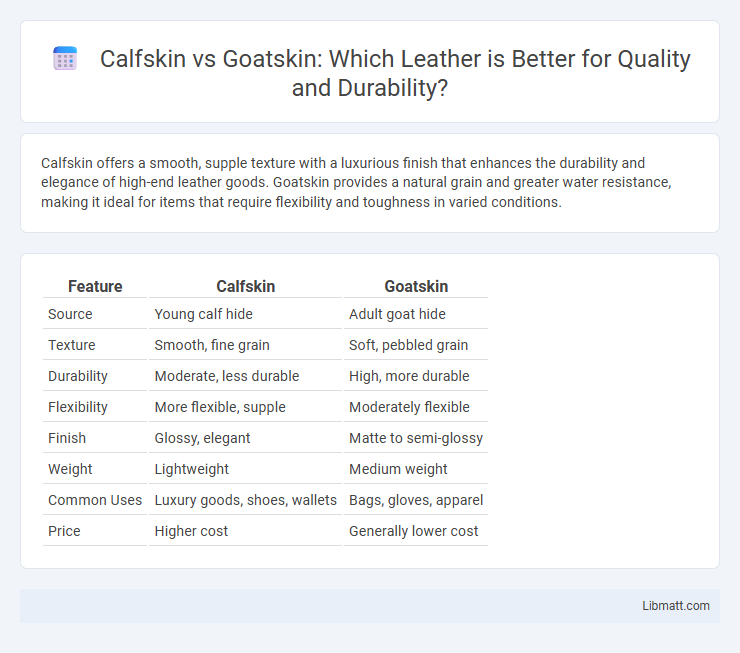Calfskin offers a smooth, supple texture with a luxurious finish that enhances the durability and elegance of high-end leather goods. Goatskin provides a natural grain and greater water resistance, making it ideal for items that require flexibility and toughness in varied conditions.
Table of Comparison
| Feature | Calfskin | Goatskin |
|---|---|---|
| Source | Young calf hide | Adult goat hide |
| Texture | Smooth, fine grain | Soft, pebbled grain |
| Durability | Moderate, less durable | High, more durable |
| Flexibility | More flexible, supple | Moderately flexible |
| Finish | Glossy, elegant | Matte to semi-glossy |
| Weight | Lightweight | Medium weight |
| Common Uses | Luxury goods, shoes, wallets | Bags, gloves, apparel |
| Price | Higher cost | Generally lower cost |
Introduction to Calfskin and Goatskin
Calfskin and goatskin are premium leathers known for durability and texture. Calfskin features a smooth, fine grain, ideal for luxury goods and sensitive to wear but ages beautifully. Goatskin offers a naturally pebbled surface, providing enhanced resistance to scratches and moisture, making it suitable for rugged, long-lasting products.
Origins and Sourcing of Calfskin vs Goatskin
Calfskin originates from young calves, primarily sourced from dairy or veal industries in Europe and North America, valued for its fine grain and smooth texture. Goatskin is derived from mature goats, predominantly sourced from regions like India, Pakistan, and North Africa, known for its durability and natural water resistance. Both leathers carry distinct qualities shaped by their animal origins and regional tanning traditions, influencing their use in luxury goods and rugged applications.
Texture and Appearance Comparison
Calfskin features a smooth, fine-grain texture with a glossy finish, making it ideal for luxury leather goods that demand sleek elegance. Goatskin offers a more pronounced grain and natural pebbling, providing durability and a distinct, rustic appearance favored in both fashion and accessories. When choosing leather for your products, consider calfskin for a refined, polished look and goatskin for textured, long-lasting character.
Durability and Longevity Differences
Calfskin offers a smoother texture with moderate durability, making it ideal for items requiring a refined appearance but less frequent heavy use. Goatskin is known for its superior toughness and natural water resistance, providing greater longevity and resilience against wear and tear. When choosing leather, your decision should consider whether you prioritize a softer feel or enhanced durability for long-term use.
Flexibility and Softness Factors
Calfskin offers exceptional softness and a smooth texture due to its fine grain, making it ideal for luxury leather goods requiring supple flexibility. In contrast, goatskin provides a slightly coarser grain but excels in flexibility and durability, often preferred for products needing resilience alongside soft touch. Both leathers balance softness and flexibility differently, with calfskin leaning towards refined elegance and goatskin towards robust pliability.
Weight and Thickness Comparison
Calfskin is generally thicker and heavier compared to goatskin, offering a denser texture ideal for durable leather products. Goatskin is lighter and more flexible due to its thinner grain, making it suitable for items that require softness and ease of movement. Understanding the weight and thickness differences between calfskin and goatskin helps you choose the best leather for your specific application.
Maintenance and Care Requirements
Calfskin requires gentle cleaning with a soft, damp cloth and occasional application of leather conditioner to maintain its smooth texture and prevent drying or cracking. Goatskin, known for its natural oils and durability, demands less frequent conditioning but should still be cleaned regularly to remove dirt and moisture buildup. Both types benefit from storage in a cool, dry place away from direct sunlight to preserve their quality and longevity.
Applications in Leather Goods
Calfskin leather is prized for its smooth texture and durability, making it ideal for high-end fashion items such as wallets, handbags, and dress shoes that require a supple yet sturdy material. Goatskin leather offers a distinct grain and superior flexibility, often used in gloves, bookbinding, and durable outerwear where softness and resistance to wear are essential. Both types provide unique advantages tailored to different leather goods, with calfskin favored for luxury aesthetics and goatskin valued for its resilience and comfort.
Price and Value Considerations
Calfskin typically commands a higher price due to its finer grain, softness, and durability, making it a popular choice for luxury leather goods. Goatskin, while generally more affordable, offers excellent toughness and water resistance, providing strong value for everyday items. You should weigh the premium cost of calfskin against the robust practicality and savings that goatskin delivers.
Which is Better: Calfskin or Goatskin?
Calfskin offers a smooth, fine grain and exceptional durability, making it ideal for high-end leather goods that require a polished appearance and long-lasting quality. Goatskin is prized for its natural softness, flexibility, and water resistance, providing a more rugged texture suitable for items needing resilience in various conditions. Your choice between calfskin and goatskin should depend on whether you prioritize refined aesthetics and strength or supple texture and weather resistance.
Calfskin vs goatskin Infographic

 libmatt.com
libmatt.com